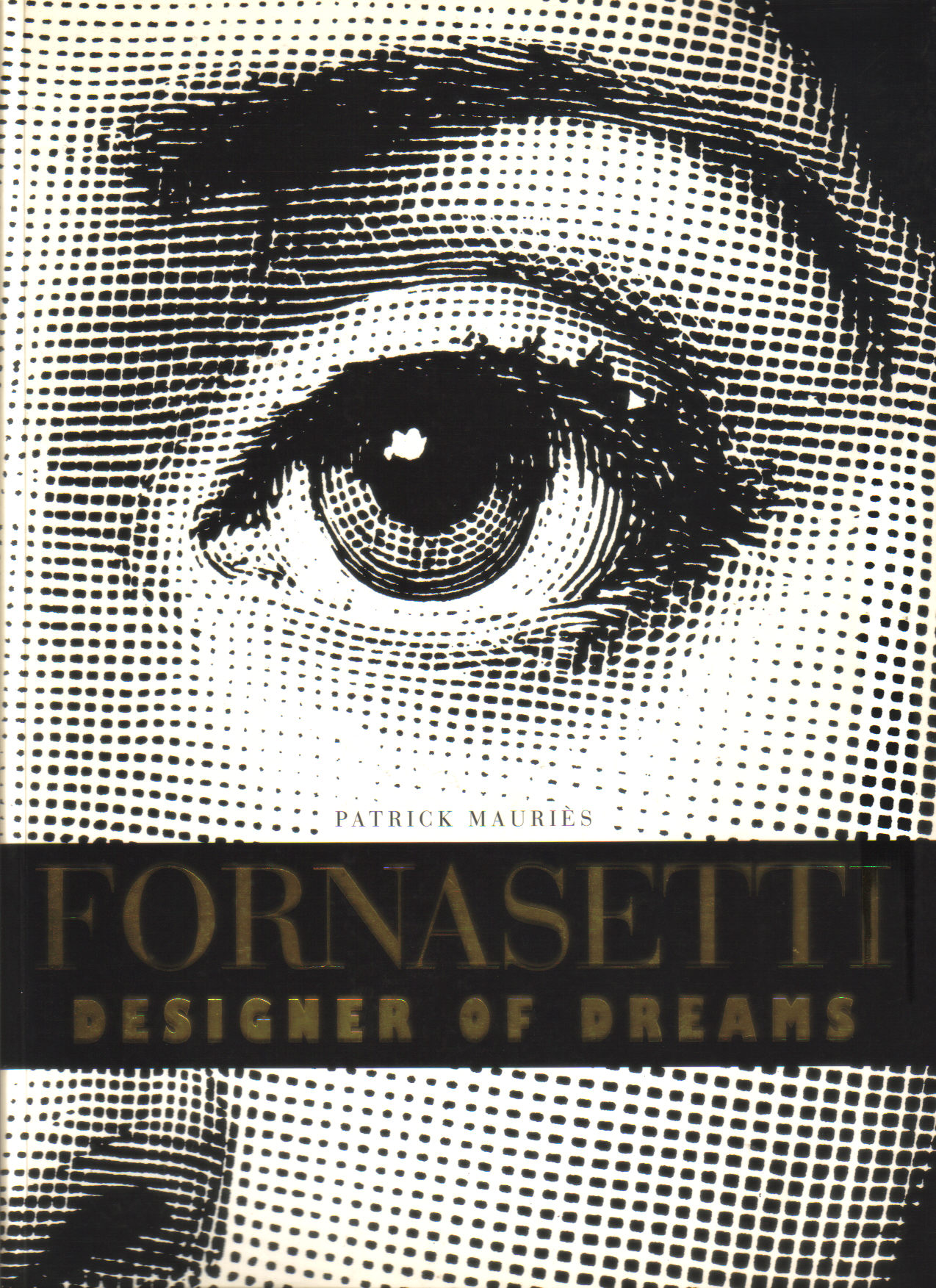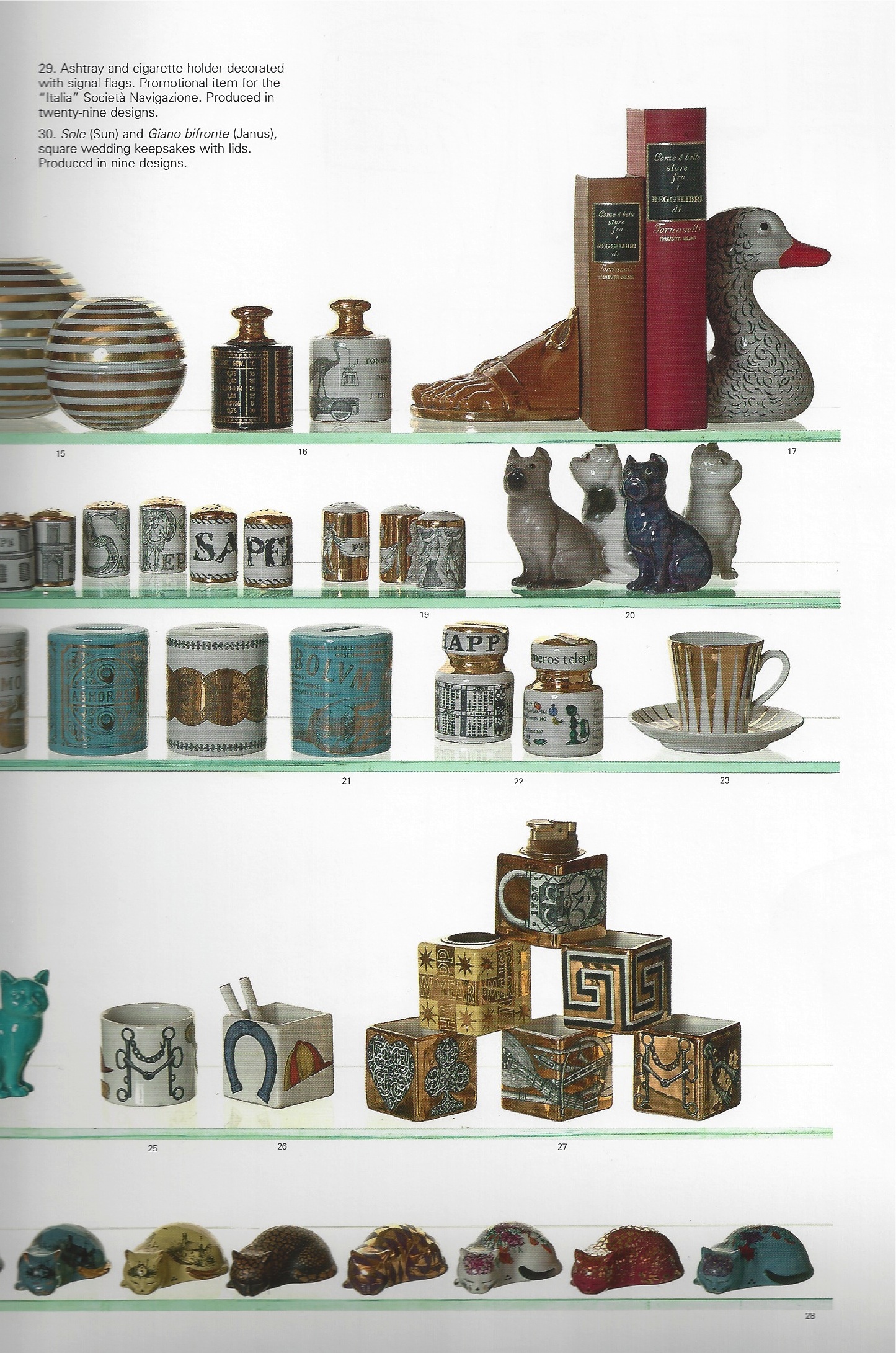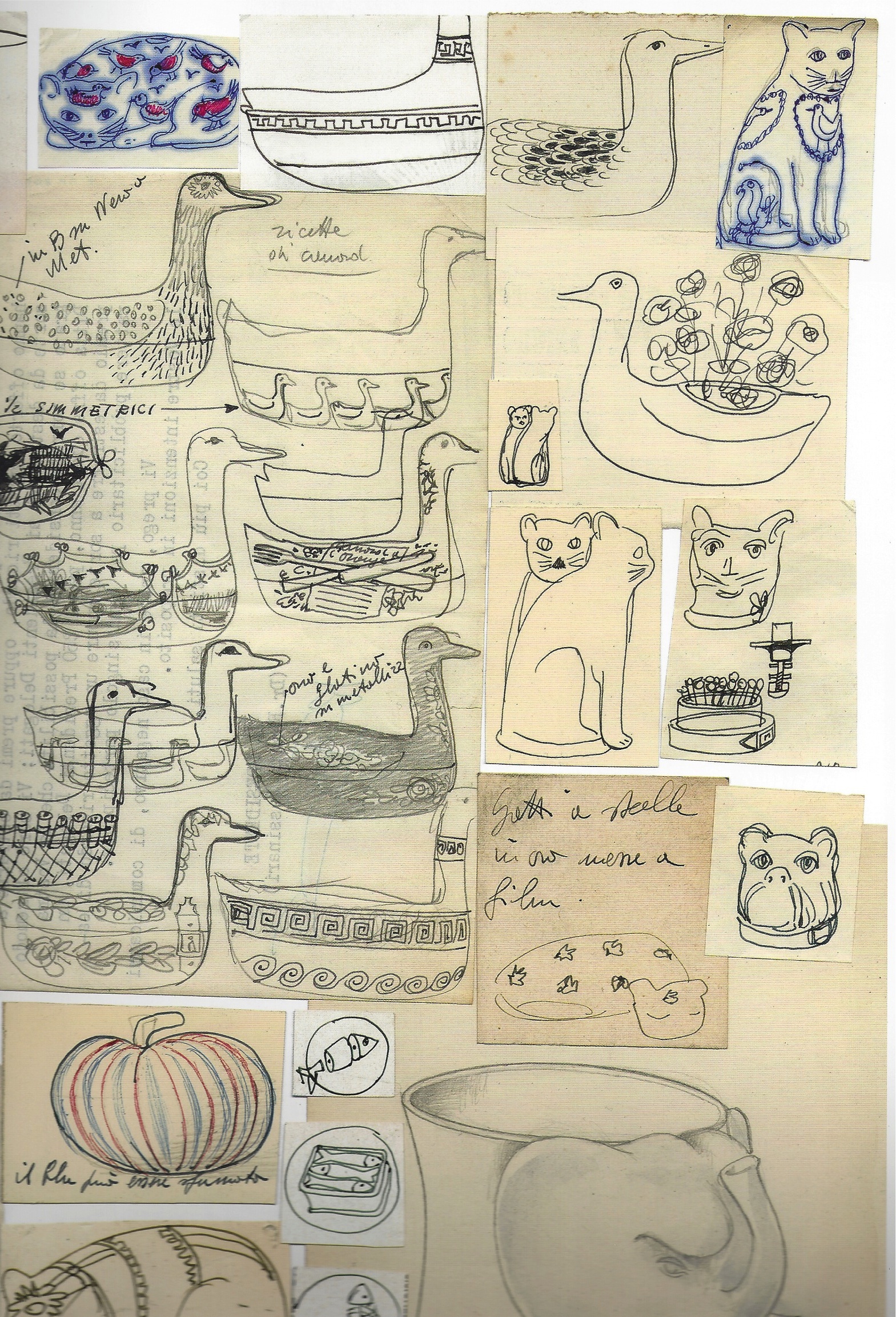(1) Ogetti con nastro (Objects Under a Ribbon), A Lithographically and Transfer-Printed Metal Paper Basket
(2) Carrozze (Carriages), A Lithographically and Transfer-Printed Metal Umbrella Stand
(3) Levriero afgano (Afghan Hound), A Lithographically and Transfer-Printed Metal Umbrella Stand
(4) Coromandel (Coromandel), A Lithographically and Transfer-Printed Metal Umbrella Stand
(5) Volute Nero su Rosso (Volutes Black on Red), A Lithographically and Transfer-Printed Metal Umbrella Stand
(6) Striscie verticali Verde e rosso (Vertical Stripes, Green and Red), A Lithographically and Transfer-Printed Metal Paper Basket
(7) Profili di donna (Profiles of Women), A Lithographically and Transfer-Printed Metal Umbrella Stand
(8) Striscie verticali Nero e bleu (Vertical Stripes, Black and Blue), A Lithographically and Transfer-Printed Metal Paper Basket
(9) Striscie verticali Rubino e bleu (Vertical Stripes, Ruby and Blue), A Lithographically and Transfer-Printed Metal Paper Basket
(10) A Pair of Carlino Porcelain Pugs
By Piero Fornasetti, circa 1950s
With the firm's paper label on the underside FORNASETTI MILANO MADE IN ITALY
10 ¾ in (27 cm) high, 10 ¼ in (26 cm) diameter
cf. Patrick Mauries, Fornasetti: Designer of Dreams, exh. cat., London, 1991, p.183 – for an illustration of an interior including the identical paper basket
Barnaba Fornasetti, ed., Fornasetti: The Complete Universe, 2010, p.476, fig.109 – for an illustration of a black and white version
10 ¾ in (27 cm) high, 10 ¼ in (26 cm) diameter
cf. Patrick Mauries, Fornasetti: Designer of Dreams, exh. cat., London, 1991, p.183 – for an illustration of an interior including the identical paper basket
Barnaba Fornasetti, ed., Fornasetti: The Complete Universe, 2010, p.476, fig.109 – for an illustration of a black and white version
(2) Carrozze (Carriages), A Lithographically and Transfer-Printed Metal Umbrella Stand
By Piero Fornasetti, circa 1960s
With the original paper label CARROZZE colore su bianco, stamped with the firm's mark on the underside FORNASETTI MILANO MADE IN ITALY
22 ¼ in (57.1 cm) high
cf. Barnaba Fornasetti, ed., Fornasetti: The Complete Universe, 2010, p. 475, fig.104 – for an illustration of the identical umbrella stand
22 ¼ in (57.1 cm) high
cf. Barnaba Fornasetti, ed., Fornasetti: The Complete Universe, 2010, p. 475, fig.104 – for an illustration of the identical umbrella stand
(3) Levriero afgano (Afghan Hound), A Lithographically and Transfer-Printed Metal Umbrella Stand
By Piero Fornasetti, circa 1950s
With the firm's original paper label on the reverse FORNASETTI MILANO MADE IN ITALY
29 ½ in (75 cm) high, 15 in (38 cm) wide
cf. Barnaba Fornasetti, ed., Fornasetti: The Complete Universe, 2010, p.379, fig.108, p.466, fig.31, p.467, fig.41
29 ½ in (75 cm) high, 15 in (38 cm) wide
cf. Barnaba Fornasetti, ed., Fornasetti: The Complete Universe, 2010, p.379, fig.108, p.466, fig.31, p.467, fig.41
(4) Coromandel (Coromandel), A Lithographically and Transfer-Printed Metal Umbrella Stand
By Piero Fornasetti, circa 1950s
With the firm's original paper label on the underside FORNASETTI MILANO MADE IN ITALY
22 ¼ in (57.1 cm) high
cf. Barnaba Fornasetti, ed., Fornasetti: The Complete Universe, 2010, p.475, fig.104 – for an illustration of the identical umbrella stand
22 ¼ in (57.1 cm) high
cf. Barnaba Fornasetti, ed., Fornasetti: The Complete Universe, 2010, p.475, fig.104 – for an illustration of the identical umbrella stand
(5) Volute Nero su Rosso (Volutes Black on Red), A Lithographically and Transfer-Printed Metal Umbrella Stand
By Piero Fornasetti, circa 1960s
With the original paper label PORTA OMBRELLI 0 26 FREGIO ROMANO nero su rosso, stamped on the underside with the firm's mark FORNASETTI MILANO MADE IN ITALY
22 ¼ in (57.1 cm) high
cf. Barnaba Fornasetti, ed., Fornasetti: The Complete Universe, 2010, p.474, fig.103 – for an illustration of a version in black and gold
22 ¼ in (57.1 cm) high
cf. Barnaba Fornasetti, ed., Fornasetti: The Complete Universe, 2010, p.474, fig.103 – for an illustration of a version in black and gold
(6) Striscie verticali Verde e rosso (Vertical Stripes, Green and Red), A Lithographically and Transfer-Printed Metal Paper Basket
By Piero Fornasetti, circa 1960s
With the original paper label PORTA CARTA 0 26 STRISCIE VERTICALI VERDE E ROSSO, stamped on the underside with the firm's mark FORNASETTI MILANO MADE IN ITALY
10 ¾ in (27 cm) high, 10 ¼ in (26 cm) diameter
cf. Barnaba Fornasetti, ed., Fornasetti: The Complete Universe, 2010, p.487, fig.221 – for an illustration of a red and white version
Patrick Mauries, Fornasetti: Designer of Dreams, exh. cat., London, 1991, p. 158 – for a black and white photograph of the identical paper basket displayed in Fornasetti's shop in the 1960s
10 ¾ in (27 cm) high, 10 ¼ in (26 cm) diameter
cf. Barnaba Fornasetti, ed., Fornasetti: The Complete Universe, 2010, p.487, fig.221 – for an illustration of a red and white version
Patrick Mauries, Fornasetti: Designer of Dreams, exh. cat., London, 1991, p. 158 – for a black and white photograph of the identical paper basket displayed in Fornasetti's shop in the 1960s
(7) Profili di donna (Profiles of Women), A Lithographically and Transfer-Printed Metal Umbrella Stand
By Piero Fornasetti, circa 1960s
Stamped with the firm's mark on the underside FORNASETTI MILANO MADE IN ITALY
22 ¼ in (57.1 cm) high
cf. Barnaba Fornasetti, ed., Fornasetti: The Complete Universe, 2010, p.471, fig.59-60 – for an illustration of a yellow version and a colour guide on paper from the mid-1950s
22 ¼ in (57.1 cm) high
cf. Barnaba Fornasetti, ed., Fornasetti: The Complete Universe, 2010, p.471, fig.59-60 – for an illustration of a yellow version and a colour guide on paper from the mid-1950s
(8) Striscie verticali Nero e bleu (Vertical Stripes, Black and Blue), A Lithographically and Transfer-Printed Metal Paper Basket
By Piero Fornasetti, circa 1960s
With a portion of the original paper label PORTA CARTA 0 26 INTER, stamped on the underside with the firm's mark FORNASETTI MILANO MADE IN ITALY
10 ¾ in (27 cm) high, 10 ¼ in (26 cm) diameter
cf. Barnaba Fornasetti, ed., Fornasetti: The Complete Universe, 2010, p.487, fig.221 – for an illustration of a red and white version
Patrick Mauries, Fornasetti: Designer of Dreams, exh. cat., London, 1991, p. 158 – for a black and white photograph of the identical paper basket displayed in Fornasetti's shop in the 1960s
10 ¾ in (27 cm) high, 10 ¼ in (26 cm) diameter
cf. Barnaba Fornasetti, ed., Fornasetti: The Complete Universe, 2010, p.487, fig.221 – for an illustration of a red and white version
Patrick Mauries, Fornasetti: Designer of Dreams, exh. cat., London, 1991, p. 158 – for a black and white photograph of the identical paper basket displayed in Fornasetti's shop in the 1960s
(9) Striscie verticali Rubino e bleu (Vertical Stripes, Ruby and Blue), A Lithographically and Transfer-Printed Metal Paper Basket
By Piero Fornasetti, circa 1960s
With the original paper label PORTA CARTA 0 26 STRISCIE VERTICALI RUBINO E BLEU, stamped on the underside with the firm's mark FORNASETTI MILANO MADE IN ITALY
10 ¾ in (27 cm) high, 10 ¼ in (26 cm) diameter
cf. Barnaba Fornasetti, ed., Fornasetti: The Complete Universe, 2010, p.487, fig.221 – for an illustration of a red and white version
Patrick Mauries, Fornasetti: Designer of Dreams, exh. cat., London, 1991, p. 158 – for a black and white photograph of the identical paper basket displayed in Fornasetti's shop in the 1960s
10 ¾ in (27 cm) high, 10 ¼ in (26 cm) diameter
cf. Barnaba Fornasetti, ed., Fornasetti: The Complete Universe, 2010, p.487, fig.221 – for an illustration of a red and white version
Patrick Mauries, Fornasetti: Designer of Dreams, exh. cat., London, 1991, p. 158 – for a black and white photograph of the identical paper basket displayed in Fornasetti's shop in the 1960s
(10) A Pair of Carlino Porcelain Pugs
By Piero Fornasetti, circa 1950
Each stamped twice with the firm's marks
Each pug: 15 ¼ in (38.7 cm) high
cf. Barnaba Fornasetti, ed., Fornasetti: The Complete Universe, 2010, p.561, 567, 570
Each pug: 15 ¼ in (38.7 cm) high
cf. Barnaba Fornasetti, ed., Fornasetti: The Complete Universe, 2010, p.561, 567, 570
Umbrella Stands: Piero Fornaset's creative openness is demonstrated by his development of his type of umbrella stand. He was struck by the cylindrical shape of a type of masonite tube that was used in power plants as an insulating covering for certain components. The tubes were 10 ¼ inches in diameter and he cut them to lengths of about 23 ½ inches. The largest tubes were perfect for making the columns of umbrella stands.
Masonite was an ideal support for nitro lacquer, and it tolerated a wide range of temperature without cracking. The stand was produced by gluing a plywood base to the bottom, with a small basin to protect the stand from water damage; in the earliest versions this basin was made of aluminium, but later plastic was used. The stand was further embellished by adding a brass lip around the upper rim. The result was a most practical shape to place at the entrance to a home to hold umbrellas and canes, thus an item of furniture with a certain importance.
In the mid-1950s, the masonite tube was replaced by a piece of sheet metal calendared and soldered. On the basis of this shape, a Fornasettian archetype, an enormous number of decorations was created, most of which went into production in the 1950s, with a few new ones added in the early 1960s.
Porcelain Pugs: Around 1947, under the influence of Gio Ponti, Piero Fornasetti's ceramics started to gain renown. Most of his work in ceramics dates from the mid-1950s to mid-1960s. During that period, his archive was enriched by thousands of new designs. Cats were a favourite subject for his ceramics, but he also made pug dogs which became much sought-after by his clients. A similar pair of dogs by the French artist Emile Gallé was the inspiration for these two.
Paper Baskets: The road that led Piero Fornasetti to create this type of paper basket demonstrates his creative openness. He was struck by the cylindrical shape of a type of masonite tube that was used in power plants as an insulating covering for certain components. He cut the tubes that were 10 ¼ inches in diameter to lengths of about 23 ½ inches. The largest tubes were perfect for making the columns of umbrella stands. They could then be cut down to make paper baskets.
The masonite was an ideal support for the nitro lacquer, and it resisted the wide ranges of temperature without cracking. The stand was produced by gluing a plywood base to the bottom, with a small basin to protect the stand from water damage; in the earliest versions this basin was made of aluminum, but later it was made of plastic. The stand was further embellished by adding a brass lip around the upper rim. The result was the most logical shape to place in the home for a functional and yet decorative piece of art.
In the mid-1950s the masonite tube was replaced by a piece of sheet metal calendered and soldered. On the basis of this shape, a Fornasettian archetype, an enormous number of decorations was created, most of which went into production in the 1950s, with a few new ones added in the early 1960s.
Porcelain Pugs: Around 1947, under the influence of Gio Ponti, Piero Fornasetti's ceramics started to gain renown. Most of his work in ceramics dates from the mid-1950s to mid-1960s. During that period, his archive was enriched by thousands of new designs. Cats were a favourite subject for his ceramics, but he also made pug dogs which became much sought-after by his clients. A similar pair of dogs by the French artist Emile Gallé was the inspiration for these two.
Paper Baskets: The road that led Piero Fornasetti to create this type of paper basket demonstrates his creative openness. He was struck by the cylindrical shape of a type of masonite tube that was used in power plants as an insulating covering for certain components. He cut the tubes that were 10 ¼ inches in diameter to lengths of about 23 ½ inches. The largest tubes were perfect for making the columns of umbrella stands. They could then be cut down to make paper baskets.
The masonite was an ideal support for the nitro lacquer, and it resisted the wide ranges of temperature without cracking. The stand was produced by gluing a plywood base to the bottom, with a small basin to protect the stand from water damage; in the earliest versions this basin was made of aluminum, but later it was made of plastic. The stand was further embellished by adding a brass lip around the upper rim. The result was the most logical shape to place in the home for a functional and yet decorative piece of art.
In the mid-1950s the masonite tube was replaced by a piece of sheet metal calendered and soldered. On the basis of this shape, a Fornasettian archetype, an enormous number of decorations was created, most of which went into production in the 1950s, with a few new ones added in the early 1960s.


















